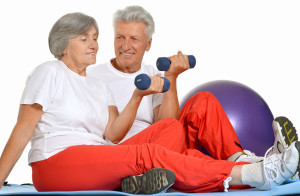Written by Greg Arnold, DC, CSCS. Thirty-two elderly women, who supplemented with beta-hydroxy-beta-methylbutyric acid (HMP) and participated in aerobic resistance exercises for 8 weeks, had a significant 1.5% improvement in a 6-minute walking test, a 31.3% hand grip endurance test and a 10.9% leg extension and strength test when compared to the placebo group.
 HMB, also known as beta-hydroxy-beta-methylbutyric acid, is a breakdown product of the amino acid leucine. It has been studied extensively for its potential benefits to sports performance 1,2 by helping prevent muscle breakdown after strenuous exercise 3,4.
HMB, also known as beta-hydroxy-beta-methylbutyric acid, is a breakdown product of the amino acid leucine. It has been studied extensively for its potential benefits to sports performance 1,2 by helping prevent muscle breakdown after strenuous exercise 3,4.
In a July 2015 study 5, young elite male rowers experienced a significant performance benefit after taking 3 grams per day of HMB for 12 weeks. This included 4% increased lung capacity in the HMB group (compared to a 1.5% decrease in the placebo group (p < 0.001 between the 2 groups) and a 12.9% increased power output in the HMB group compared to a 1.8% decrease in the placebo group (p < 0.012 between the 2 groups).
Now a study released later in 2015 6 suggests that HMB may also benefit elderly subjects. In the study, 65 women aged 64 to 73 consumed either 1.5 grams of HMB (32 women) or a placebo (33 women) for 8 weeks. The women were independently involved in a twice-weekly “mild fitness program” that included “aerobic exercises designed to improve speed of muscle contraction, and only a small part of it was dedicated to resistance exercises, essentially to improve handgrip strength”. Fifty women completed the study.
Before and after the study, the women underwent three physical function tests (4-meter walking time, repeated chair stands, and standing balance in increasingly challenging positions) of the Sports Physical Performance Battery 7. In addition, each woman did a 6-minute walking test 8 and also did a handgrip test to measure strength and endurance. This involved holding the grip at 50% of their max grip strength for as long as they could) 9. Finally, each woman did three different tests of leg strength.
After 8 weeks, no significant difference was noted between the two groups regarding the Sports Physical Performance Battery (p = 0.92) or handgrip strength (p = 0.69). Significant improvements were noted, however, in the 6-minute test, handgrip endurance, and the three leg strength tests:
| HMB | Placebo | p-value between groups | |
|---|---|---|---|
| 6-minute walking test (meters) | 3.9% increase (498.72 to 518.40) | 2.4% increase (511.71 to 524.11) | 0.04 |
| Handgrip endurance (seconds) | 20% increase (74.65 to 89.66) | 11.3% decrease (93.46 to 82.95) | 0.02 |
| Leg isokinetic flexion (Newton-meters) | 9.7% increase (25.13 to 27.57) | 3.8% increase (25.13 to 26.10) | 0.03 |
| Leg isokinetic extension (Nm) | 0.7% increase (55.73 to 55.77) | 6.1% decrease (54.23 to 50.94) | 0.03 |
| Leg isometric strength (Nm) | 10% increase (75.50 to 83.07) | 0.9% decrease (77.00 to 76.35) | 0.02 |
For the researchers, “These findings suggest a role for HMB supplementation…to preventing or delaying the age-related decline in some physical performance parameters”. They added that “Further research is needed and should also compare the SPPB with other physical performance parameters.”
Source: Berton L, Bano G, Carraro S, Veronese N, Pizzato S, Bolzetta F, et al. (2015) Effect of Oral Beta-Hydroxy-Beta-Methylbutyrate (HMB) Supplementation on Physical Performance in Healthy Old Women Over 65 Years: An Open Label Randomized Controlled Trial. PLoS ONE 10(11): e0141757. doi:10.1371/journal.pone.0141757
Copyright: © 2015 Berton et al. Creative Commons Attribution License
Click here to read the full text study.
Posted March 10, 2017.
Greg Arnold is a Chiropractic Physician practicing in Hauppauge, NY. You can contact Dr. Arnold directly by emailing him at PitchingDoc@msn.com or visiting his web site at www.PitchingDoc.com.
References:
- Froiland K, Koszewski W, Hingst J, Kopecky L. Nutritional supplement use among college athletes and their sources of information. International journal of sport nutrition and exercise metabolism. 2004;14(1):104-120.
- Portal S, Zadik Z, Rabinowitz J, et al. The effect of HMB supplementation on body composition, fitness, hormonal and inflammatory mediators in elite adolescent volleyball players: a prospective randomized, double-blind, placebo-controlled study. European journal of applied physiology. 2011;111(9):2261-2269.
- Zanchi NE, Gerlinger-Romero F, Guimaraes-Ferreira L, et al. HMB supplementation: clinical and athletic performance-related effects and mechanisms of action. Amino acids. 2011;40(4):1015-1025.
- Pimentel GD, Rosa JC, Lira FS, et al. β-Hydroxy-β-methylbutyrate (HMβ) supplementation stimulates skeletal muscle hypertrophy in rats via the mTOR pathway. Nutrition & metabolism. 2011;8(1):11.
- Durkalec-Michalski K, Jeszka J. The efficacy of a β-hydroxy-β-methylbutyrate supplementation on physical capacity, body composition and biochemical markers in elite rowers: a randomised, double-blind, placebo-controlled crossover study. Journal of the International Society of Sports Nutrition. 2015;12(1):31.
- Berton L, Bano G, Carraro S, et al. Effect of oral beta-hydroxy-beta-methylbutyrate (HMB) supplementation on physical performance in healthy old women over 65 years: an open label randomized controlled trial. PloS one. 2015;10(11):e0141757.
- Guralnik JM, Simonsick EM, Ferrucci L, et al. A short physical performance battery assessing lower extremity function: association with self-reported disability and prediction of mortality and nursing home admission. Journal of gerontology. 1994;49(2):M85-M94.
- Guyatt GH, Sullivan MJ, Thompson PJ, et al. The 6-minute walk: a new measure of exercise capacity in patients with chronic heart failure. Canadian Medical Association Journal. 1985;132(8):919.
- Jakobsen LH, Rask IK, Kondrup J. Validation of handgrip strength and endurance as a measure of physical function and quality of life in healthy subjects and patients. Nutrition. 2010;26(5):542-550.
